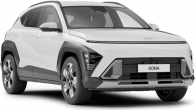If you're looking for the genesis of the small SUV apocalypse currently decimating small car sales, look no further than Mazda's CX-3.
Sure, others had done small SUVs earlier (the Kia Soul for one, and there were others), but it wasn't until the launch of Mazda's sleek little CX-3 - though don't let the numbers fool you, it's actually based on the Mazda2 - that the segment really got moving.
Even now, several years after its launch, the CX-3 sits outright-second on the segment sales charts, a whisker behind the Mitsubishi ASX, and miles clear of its third-place rival. Which would normally be a cause for celebration in the Mazda camp.
But there's a problem. Last year, the CX-3 was outright first. And so earlier this year, Mazda released a nipped-and-tucked version of its popular micro-SUV, presumably to try and improve its sales position by one.
So, we spent a week behind the wheel of the mid-spec (and most popular) CX-3 Maxx to see what's new.
Mazda CX-3 2018: Neo (FWD)
| Engine Type | Inline 4, 2.0L |
|---|---|
| Fuel Type | Unleaded Petrol |
| Fuel Efficiency | 6.1L/100km (combined) |
| Seating | 5 |
| Price From | $16,830 - $21,560 |
| Safety Rating |
|
Is there anything interesting about its design?
9 / 10
The good news is, it still looks very good. But mostly because it hasn't really changed.
And that's no bad thing. In fact, we think it might be the best-looking option in its segment - something that has hurt its sales not at all - owing mostly to its swooping, perfectly-proportioned exterior that makes the CX-3 look both fashionable and fast.
.jpg)
Mazda’s littlest SUV is unashamedly built for the city, but the use of black body cladding lends a vague sense of ruggedness to its design, while the power-domed bonnet hints at sportiness - even if it never quite materialises from behind the wheel.
Climb inside, and the CX-3’s interior is simple and unfussy, with a padded panel that runs the length of the dash breaking up the harder plastics. It's a clean and premium-feeling design, and only the materials in places would prevent it from looking at home on a far more expensive model.
.jpg)
How practical is the space inside?
6 / 10
You can basically split the city-size SUV field into two categories: small and smaller. And the CX-3 falls into the latter category. The 4275mm long, 1765mm wide and 1550mm tall CX-3 is based on the Mazda2 city car, so while it might be the most stylish in its segment, it’s not the most practical.
Life is good for front seat riders, though, where the cabin doesn’t feel tight at all. There are two cupholders on offer, along with two USB points and a 12V power source, and each of the front doors has room for bottles.
Things do get tighter in the backseat, where even a single (bulky) car seat can swallow up most of the available space - something I know from personal experience. Best stick to two grown-up passengers back there, too, as shoulder room feels much tighter than legroom.
.jpg)
Backseat riders are at the mercy of the driver and front passenger when it comes to entertainment or climate, with no USB outlets or air vents. But there are two ISOFIX attachment points, one in each window seat in the back.
Boot space is a roadtrip-limiting 264 litres with the 60/40 split rear seats in place, but that number grows to a usable 1174 litres when they're folded flat.
Does it represent good value for the price? What features does it come with?
8 / 10
CX-3 pricing kicks off with the Maxx from $22,890, but that money will buy you a manual transmission (which nobody wants). Instead, our automatic-equipped test car lists at $24,890 in front-wheel drive (FWD), and $26,890 for the all-wheel drive (AWD) version.
That money will secure you 16-inch alloy wheels, keyless entry (and push-button start) outside, while inside you'll find cloth seats, manual air-con, cruise control and sat nav, along with a leather-wrapped gear shift, handbrake and steering wheel - the latter with wheel-mounted controls.
.jpg)
Tech is covered by a 7.0-inch colour screen that pairs with a six-speaker stereo, and also arrives with internet radio apps - but no Apple CarPlay or Android Auto.
What are the key stats for the engine and transmission?
7 / 10
The CX-3’s naturally aspirated 2.0-litre petrol engine produces 109kW at 6000rpm and 192Nm at 2800rpm - plenty in a car that weighs 1282kg - sending that power to the front wheels (though an AWD option is available) via a six-speed automatic transmission.
.jpg)
How much fuel does it consume?
7 / 10
Offical claimed fuel use is pegged at a frugal 6.1 litres per hundred kilometres on the combined cycle, with emissions a claimed 146g/km of C02. The CX-3’s 48-litre fuel tank will accept cheaper 91RON fuel, too.
What's it like to drive?
8 / 10
The great white shark has evolved over millions of years to become the perfect apex predator, perched at the very top of its food chain. Just so long as you keep it in the ocean. Drop one in the Serengeti, for example, and things aren't looking quite so rosy for old Jaws.
And it’s the same with Mazda’s little CX-3, only in fast-forward. The city SUV segment has only had the a handful years to complete the evolution process, but its been every bit as effective. Keep the CX-3 in its natural, urban habitat and it feels positively meant to be.
The engine feels perky and smooth if you use gentle inputs, the steering is light and direct, and its diminutive dimensions make it an absolute doddle to park just about anywhere.
Vision from up front is great, and it’s a mostly quiet and smooth drive across the city’s blacktop.
Vision from up front is great, and it’s a mostly quiet and smooth drive across the city’s blacktop. It shines on twisting roads, too, where the firm-ish suspension inspires confidence, and the smooth surge of the naturally aspirated engine shifts the little CX-3 in and out of corners with ease.
But venture outside the city walls and it feels out of its depth. This is not designed as a long-distance cruiser. For one, the engine can get a little loud and unrefined when you really plant your foot, and with the rear seats in place, the boot is really only big enough for a pair of soft bags - big, hard suitcases need not apply. Road noise, too, creeps in at freeway speeds. Like a shark in the Serengeti, then.
But it should surprise nobody that CX-3 shines brightest in town. And if you’re city-dweller, the CX-3 is a popular choice for a reason.
Warranty & Safety Rating
What safety equipment is fitted? What safety rating?
9 / 10
It's hard to fault the safety package on the CX-3 Maxx, which is overflowing for a car at the price point.
Expect six airbags (dual front, front-sides and curtain), which are joined by rear parking sensors, a reversing camera and a clever AEB system that works in forward and reverse.
Blind-spot monitoring and rear cross-traffic alert round out the standard safety list, helping earn the CX-3 the maximum five-star ANCAP safety rating when crash tested in 2015.
What does it cost to own? What warranty is offered?
7 / 10
Mazda has not followed the long-warranty lead of Hyundai, Kia and others, instead offering a three-year/unlimited km warranty. The CX-3 will require a trip to the service centre every 12 months or 10,000km - a trip that should be made less painful thanks to capped-price servicing, with service pricing listed on Mazda's website.
Verdict
With the obvious exception of Two and a Half Men, things are usually popular for reason, and that is they're good. And the CX-3 deserves to be duking it out for the top sales spots in the segment.
It's a city car, of course, and so it shines brightest in the urban jungle, but its stylish design and top-class safety offering are pretty sizeable selling points for Australias's city dwellers.
Mazda CX-3 or Mitsubishi ASX? Fill us in on your preference in the comments below.
Pricing Guides

.jpg)


.jpg)








.png)








.jpg)
.jpg)




